The Oxford English Dictionary’s word of the year for 2015 was in fact not a word. It was the ‘Face with Tears of Joy’ emoji. This one > ?
You’ll no doubt recognise it – here’s how it looks across different platforms:
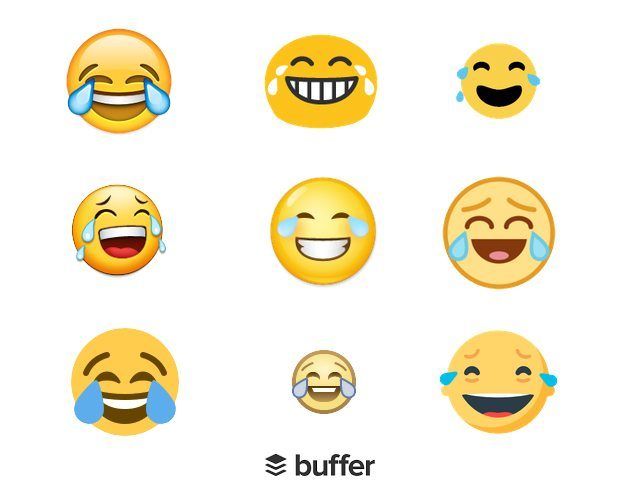
This feels like a significant acknowledgement that the way a large number of us communicate is shifting.
It’s no longer just teenagers or younger people who are using emoji’s, hashtags and neologisms – they’ve reached the mainstream.
In this post, we dig a bit deeper into how our language and communication has changed over recent years as we’ve adapted to interacting through social networks and apps, and we’ll also look at what this shift means for marketers.
Let’s go! ?
The functions of language
Before we dive into how social media has changed the way we communicate and use language, it’s first important to understand the key functions of language.
This is a subject Vyvyan Evans, Professor of Linguistics at Bangor University, explains more on over at the Oxford Dictionaries blog:
“English, like any other natural language, has two major communicative functions. The first is an ideational function: to get an idea across, as when I say, It’s raining, or I love you. It also has an interactive-interpersonal function: to influence the attitudes and behaviours of others, and, in a myriad ways, change an aspect of the world’s states of affairs in the process.”
Here’s how the two functions could look in marketing terms.
To get an idea across:
Here we have a banner from Amazon.com, very clearly letting you know there is a sale on:

To influence the attitudes and behaviours:
Here is a very different piece of marketing communication from Apple — this example feels far more aspirational and aims to influence our attitudes and behaviours.

Whenever you’re writing, whether it’s an email, tweet or blog post, it can be great to think on these major functions: Are you trying to get a point across or influence attitudes and behaviours?
More than words can say: The emoji revolution
On awarding the ‘Face with Tears of Joy’ emoji the Word of the Year title, Caspar Grathwohl, president of Oxford Dictionaries, explained:
“When you look back at the year in language, one of the most striking things was that, in terms of written communication, the most ascendant aspect of it wasn’t a word at all, it was emoji culture.”
Emoticons have been around since 1982, but only actually moved into mainstream communication over recent years as social media has grown and emojis reached phone keyboards.
Now, 6 billion emoji’s are sent every single day and according to Swyft Media, 74 percent of people in the U.S. regularly use stickers, emoticons or emojis in their online communication, sending an average of 96 emojis or stickers per day.
How people are using emojis
“The fact that English alone is proving insufficient to meet the needs of 21st-century digital communication is a huge shift.” – Casper Grathwohl
One area Twitter have noticed a lot of emoji use is in tweets about TV, where fans can discuss what’s happening, how they feel about what they’re watching.
Twitter found that the ‘Face with Tears of Joy’ emoji is by far the most popular emoji used in TV tweets:
It’s typically used to convey laughter, but it doesn’t just see prominent usage in tweets about comedy programming: it’s the top emoji across all genres, as well as all times of day. Another popular emoji is: ?
Signaling that users are loving what (or who!) they’re seeing on TV.
Here are the top 10 emojis used across TV tweets:
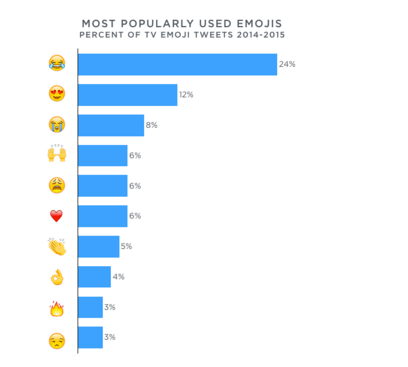
What this highlights is that we’ve moved beyond the simple smiley face and we’re now turning to emoji to convey extra meaning and emotion within the messages we send.
How emojis are replacing words
It feels like we’ve reached a point where in some cases, emojis have started to replace altogether, the words we send each other digitally, whether in an email, IM or tweet.
For example, here’s how the expression of laughter has evolved:
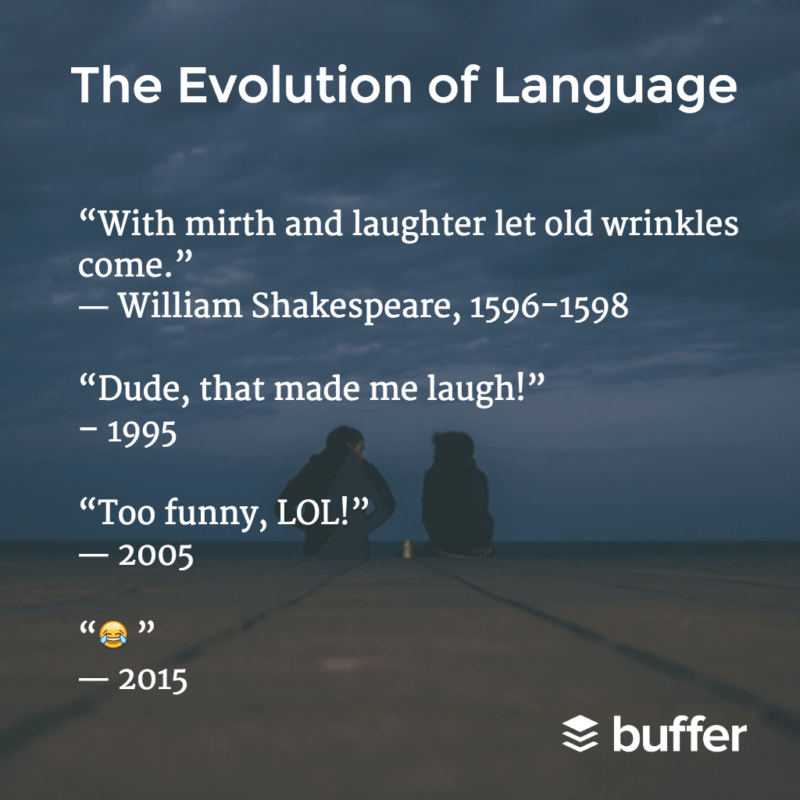
(Hat tip to Marcus for this excellent example)
This evolution is backed up by a study from Instagram. What Instagram found is that many popular emoji have meanings in-line with early internet slang and have been adopted as a way to replace these words.
Here are a few emoji and the slang Instagram found them to represent:
- ? : lolol, lmao, lololol, lolz, lmfao, lmaoo, lolololol, lol, ahahah, ahahha, loll, ahaha, ahah, lmfaoo, ahha, lmaooo, lolll, lollll, ahahaha, ahhaha, lml, lmfaooo
- ?: beautifull, gawgeous, gorgeous, perfff, georgous, gorgous, hottt, goregous, cuteeee, beautifullll, georgeous, baeeeee, hotttt, babeee, sexyyyy, perffff, hawttt
- ?: #keepitup, #fingerscrossed, aswell, haha, #impressed, #yourock, lol, #greatjob, bud, #goodjob, awesome, good, #muchlove, #proudofyou, job, #goodluck
Instagram also found that the rise in emoji popularity also correlates directly with the decline of internet slang:
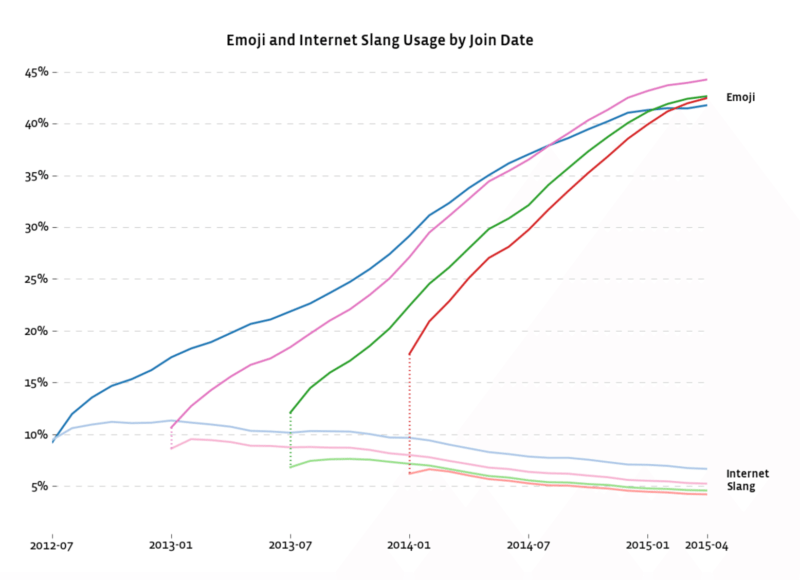
So whereas 10 years ago we may have abbreviated “that made me laugh” to “LOL”, now in 2016, we’re effectively replacing full sentences with emoji to convey the same meaning.
Emoji as a way to complement words
Communication is very visual and when it comes to text-based communication, “we’re babies,” explains Tyler Schnoebelen, a linguistics Ph.D. from Stanford, to NY Magazine.
Schnoebelen also points out that we’re only now learning to write at the speed of talking (e.g. text or instant messages) without any physical contextual clues. He explains:
If you are talking to someone face-to-face, you don’t need an additional word or symbol to express “I’m smiling” because you would, presumably, be smiling.
In the 1950’s, psychologist Albert Mehrabian, determined that only 7 percent of communication is verbal (what we say), while 38 percent is vocal (how we say it) and 55 percent is nonverbal (what we do and how we look while we’re saying it).
Here’s a great visual representation of this by Rob Tatman:
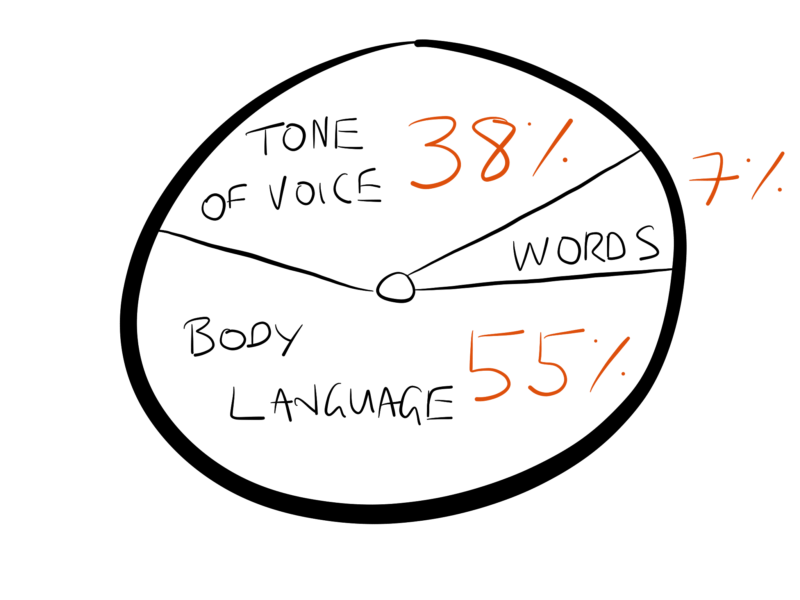
Therefore, when we’re not communicating face-to-face, the vast majority of our communication skills are negated.
Emojis have become a way to convey the tone and non-verbal context behind our texts, IMs or tweets and work amazingly alongside snippets of text as a way to give more context to a message.
Take the below tweet, for example, the use of the ‘Face with Tears of Joy’ gives some key contextual clues to the text, indicating that the tweeter was laughing as they typed:

3 more ways social media has evolved the way we communicate
1. Acronyms & abbreviations
As the Internet and mobile communication has grown, so has the collection of acronyms and abbrevations we use on a daily basis.
My first experience of communicating in this way was through SMS when I’d use abbreviations like “spk l8r” to save valuable characters in my messages.
Though, in some cases, emojis have replaced some acronyms and abbreviations, they are still very prominent in social media and have made irreversible impacts on the way we communicate.
2. Hashtags
Since they were first introduced on Twitter, hashtags – clickable keywords used to categorize content – have become increasingly important to the way we communicate – both online and offline.
Hashtags were intended to be, and are still used as, ways to follow conversations about a topic. For example, to keep up with news about my favorite football team I check #itfc.
Hashtags have also grown into a way to express our feelings and emotions. For example, ending a tweet about going on holiday with “#NoMoreCold”, could imply excitement about heading for warmer shores.
Lauren Schuhmacher explains in a Huffington Post blog post:
“What we’re gaining from hashtagging is a new way to communicate ideas, more concise than ever. We can share, with one funny little symbol, a host of ideas that are merely tangential to our original thought, but that somehow manage to clarify or add to it.”
3. Neologisms
“Social media is making it easier than ever to contribute to the evolution of language. You no longer have to be published through traditional avenues to bring word trends to the attention of the masses,” wrote Jon Reed on the Oxford Dictionaries blog.
One of the most prominent examples of this is the word “Selfie.” The earliest use of the word was traced back to a forum post in 2002 and it wasn’t until a decade later when the word became extremely popular and even found it’s way into the dictionary.
What you can see from the below graphic, though, is its meteoric rise in popularity throughout 2013:
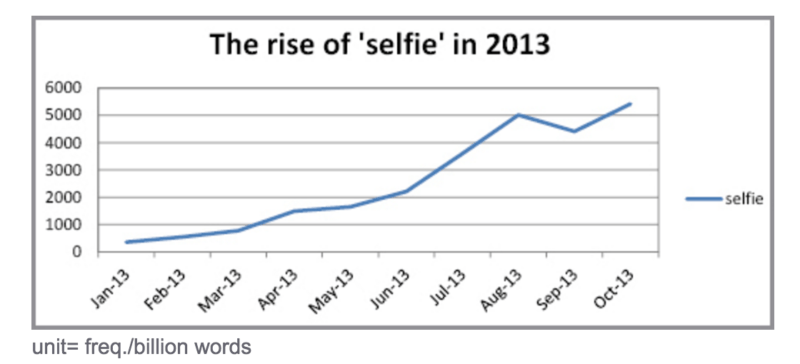
With Twitter, Facebook, Snapchat and other social media channels offering instant interaction with far-reaching audiences, it’s never been easier for words to spread and embed themselves within our day-to-day vocabulary.
Katherine Connor Martin, head of U.S. Dictionaries at Oxford University Press explained to Esquire:
It’s an amazing thing for lexicographers in this day and age, with things like Twitter—such unredacted, unedited speech—to see [words gaining in notoriety] in real time, as it offers a written record of what was once just oral slang. Slang is often very transient, first appearing in subcultures, and then tends to be proliferated online.”
What this means for marketers: 4 ways to better communicate with your customers
It feels clear that language and the way we all communicate have greatly evolved since social media hit the mainstream.
What may not be so clear is how you can use this knowledge to get the edge over your competitors. Here are the top things businesses should consider:
1. Make brand interactions and engagement simple
If the rise of social media, emoji and abbreviations teaches us anything, it’s that we are looking for more effective ways to communicate with each other, faster. The brands that win are the ones that will deliver amazingly simple customer experiences.
For a great example of this, check out how Uber and Facebook Messenger have simplified the experience of getting somewhere:
Another example is Domino’s emoji pizza delivery. Once customers have registered an ‘Easy Order’ account with Domino’s – including details of their pizza preferences – simply tweeting a pizza emoji will result in a delivery.
2. Make communication easy to follow
A big part of social media success is making your brand or campaign story easy to follow. This is something Taco Bell had great success with during their campaign
Nearly 33,000 people signed a virtual petition created by Taco Bell, pushing for a taco emoji to be created. When their request was accepted they celebrated with the #TacoEmojiEngine.
If you tweeted @TacoBell the taco emoji + any other emoji you’d then be surprised with one of 600 unique taco inspired photos, gifs or sounds.
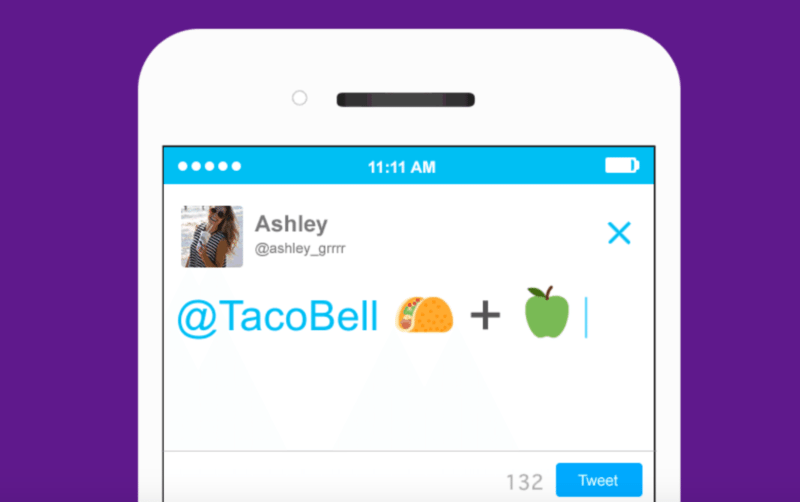
The campaign was extremely fun, but what really made it stand out to me was how they’d brought a group of taco enthusiasts together and told the story in an easy-to-follow way across social media and their website.
3. Test, test, test
Emoji and many neologisms have hit the mainstream and are becoming increasingly ingrained in popular culture. However, marketing and brand communications using emojis and newer words, phrases and abbreviations may not be for everyone.
We’re in the midst of a major shift and there’s likely to be some audiences that have embraced newer forms of communication, and will respond positively to them, and there are other audiences that aren’t quite there yet.
It could be good to start small, and test an approach that may work for your brand.
4. Tap into emotion in brand messages
Studies have shown that brands that can connect with their buyers on an emotional level will see 2 times more impact than those who are still trying to sell a business or functional value.
Try to think how the language you use and communication you send out can help build emotional connections.
It could be important to remember how emoji can help convey the tone and non-verbal context behind the copy you use in any adverts or social media posts.
Over to you
Have you noticed social media changing the way you communicate? Have you tried any marketing campaigns using emoji? I’d love to hear your thoughts and experiences.
Excited to join you in the comments! ?
Try Buffer for free
180,000+ creators, small businesses, and marketers use Buffer to grow their audiences every month.
Related Articles

In this article, Nupur Mittal shares insights into four research methods that help her find content ideas and identify unique takeaways.

Facebook marketing in 2019 isn’t dead. On the contrary, it’s far from it. Now removed from the dim outlook that businesses faced at the beginning of 2018, Facebook has and will remain an essential tool for brands’ marketing strategies moving forward. In our big State of Social Media 2019 Report, we found that 93.7 percent of businesses use and are currently active on Facebook — the most among any other social media network. And although we continue to see a dramatic rise in the usage
